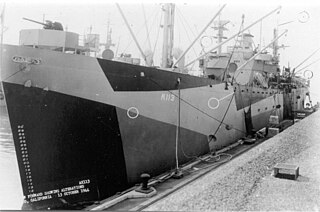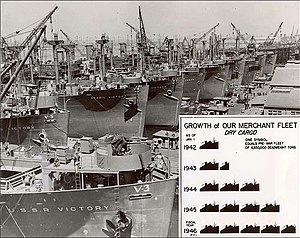
USS Rutilicus (AK-113) was a Crater-class cargo ship commissioned by the US Navy for service in World War II. She was responsible for delivering troops, goods and equipment to locations in the Asiatic-Pacific Theater.

The Type C4-class ship were the largest cargo ships built by the United States Maritime Commission (MARCOM) during World War II. The design was originally developed for the American-Hawaiian Lines in 1941, but in late 1941 the plans were taken over by the MARCOM.

The SS U.S.S.R. Victory was the third Victory ship built during World War II under the Emergency Shipbuilding program. She was launched by the California Shipbuilding Company on February 26, 1944. The ship was completed and delivered to the wartime operator of all United States oceangoing shipping, the War Shipping Administration (WSA), on April 26, 1944. U.S.S.R. Victory, official number 245247, was assigned to Moore-McCormack Lines, Inc., under a standard WSA operating agreement at that time. That agreement continued until the ship's sale on March 7, 1947. The ship’s United States Maritime Commission designation was VC2-S-AP3, hull number 3 (V-3). U.S.S.R. Victory served in the Atlantic Ocean during World War II.

The SS United States Victory was the fourth Victory ship built during World War II under the Emergency Shipbuilding program. She was launched by the California Shipbuilding Company on March 6, 1944 and completed on April 30, 1944. The ship’s United States Maritime Commission designation was VC2- S- AP3, hull number 3 (V-3). SS United States Victory served in the Pacific Ocean during World War II. The 10,500-ton Victory ships were designed to replace the earlier Liberty Ships. Liberty ships were designed to be used just for World War II. Victory ships were designed to last longer and serve the US Navy after the war. The Victory ship differed from a Liberty ship in that they were: faster, longer and wider, taller, had a thinner stack set farther toward the superstructure and had a long raised forecastle.
The SS New Zealand Victory was the sixth Victory ship built during World War II. She was launched at Terminal Island by the California Shipbuilding Company on March 20, 1944 and completed on May 13, 1944. She was built in 109 days under the Emergency Shipbuilding program. The ship’s United States Maritime Commission designation was VC2-S-AP3, hull number 6 (V-6). SS New Zealand Victory served in the Pacific Ocean during WW2. SS New Zealand Victory was sixth of the new 10,500-ton class ship to be known as Victory ships. Victory ships were designed to replace the earlier Liberty Ships. Liberty ships were designed to be used just for WW2. Victory ships were designed to last longer and serve the US Navy after the war. The Victory ship differed from a Liberty ship in that they were: faster, longer and wider, taller, a thinner stack set farther toward the superstructure and had a long raised forecastle.

The SS Sapulpa Victory was the 14th Victory ship built for the United States during World War II under the Emergency Shipbuilding program. The vessel was launched by the California Shipbuilding Company on April 29, 1944, and completed on June 19, 1944. The ship's US Maritime Commission designation was VC2-S-AP3, hull number 14 (V-14). The Sapulpa served in the Pacific Theater during World War II and was operated by the Alcoa SS Company.

The SS Bluefield Victory was the 16th Victory ship built during World War II under the Emergency Shipbuilding program. She was launched by the California Shipbuilding Company on May 9, 1944, and completed on June 30, 1944. The ship’s United States Maritime Commission designation was VC2- S- AP3, hull number 15 (V-15). SS Bluefield Victory served in the Pacific Ocean during World War II and was operated by the Mississippi Shipping Company. The 10,500-ton Victory ships were designed to replace the earlier Liberty Ships. Liberty ships were designed to be used just for World War II. Victory ships were designed to last longer and serve the US Navy after the war. The Victory ship differed from a Liberty ship in that they were: faster, longer and wider, taller, had a thinner stack set farther toward the superstructure, and had a long raised forecastle.

The SS Luray Victory was the seventeenth Victory ship, a new 10,500 ton class ship built during World War II. The California Shipbuilding Company built the ship under the Emergency Shipbuilding program. She was launched on May 11, 1944, and completed on June 26, 1944. The ship’s United States Maritime Commission designation was VC2-S-AP3, hull number 17 (V-17). The SS Luray Victory served in the Pacific Ocean during World War II and was operated by the Black Diamond Steamship Company.

SS Hagerstown Victory was a Victory ship-based troop transport built for the U.S. Army Transportation Corps (USAT) late in World War II under the Emergency Shipbuilding program. It saw service in the European Theater of Operations during 1945 and in the immediate post-war period repatriating U.S. troops. Hagerstown Victory was one of 97 cargo Victory ships converted to a troopship.

The SS Baton Rouge was a cargo Victory ship built during World War II under the Emergency Shipbuilding program. The Baton Rouge (MCV-846) was a type VC2-S-AP2 Victory ship built by Bethlehem-Fairfield Shipyards. The Maritime Administration cargo ship was the 846rd ship built. Her keel was laid on June 21, 1945. She was launched on August 22, 1945 and completed on September 24, 1945. The 10,600-ton ship was constructed for the Maritime Commission. The American Export Line and later the Isthmian Steamship Company operated her under the United States Merchant Marine act for the War Shipping Administration.
SS Bates Victory was a World War II Victory ship named after Bates College in Maine.

The SS Baylor Victory was a cargo Victory ship built during World War II under the Emergency Shipbuilding program. The Baylor Victory (MCV-772) was a type VC2-S-AP2 Victory ship built by California Shipbuilding Corporation in Los Angeles, California. The Maritime Administration cargo ship was the 772rd ship built. Her keel was laid on Jan. 13, 1945. She was launched on March 6, 1945 and completed on March 30, 1945. The 10,600-ton ship was constructed for the Maritime Commission. She operated her under the United States Merchant Marine act for the War Shipping Administration. She was named for Baylor University, a private Christian university in Waco, Texas. At her launching Baylor University was represented by 18 graduates and friends. University President Pat M. Neff gave a short speech at the launching and christening ceremony. Los Angeles District Judge Minor L. Moore, a Baylor graduate of 1900, also spoke. Baylor Victory was launched at 1:20 a.m. and was lit up by large floodlights.

SS Benjamin Ide Wheeler was a Liberty ship, a cargo ship during World War II. Built by California Shipbuilding Corporation (Calship) of Los Angeles for the United States Maritime Commission (USMC). Benjamin Ide Wheeler was Calship's 100th ship built. She was sponsored and christened by Mrs. Robert Gordon Sproul, wife of Robert Gordon Sproul President of the University of California system. She was named after Benjamin Ide Wheeler President of the University of California from 1899 to 1919. Her Hull # was 675, she was type EC2-S-C1 ship, built in 50 days as part of the Emergency Shipbuilding Program. Her keel was laid down on 28 October 1942, launched on 27 November 1942 and delivered on 17 December 1942. She was assigned to American-Hawaiian Steamship Company of San Francisco for merchant operation by the War Shipping Administration (WSA).

SS India Victory was a Victory ship built and operated as a cargo carrier and troopship in World War II. After the war the ship was used a private cargo ship. She sank on 12 July 1972, ran aground on a Pratas Reef in the South China in Typhoon Susan.

USNS Victoria (T-AK-281) was a Norwalk class Fleet Ballistic Missile Cargo Ship, which was launched as a World War II commercial Victory cargo ship SS Ethiopia Victory under the Emergency Shipbuilding program. The Victoria Victory was acquired by the U.S. Navy in 1963.

SS Augustana Victory was built and operated as Victory ship class cargo ship which operated as a cargo carrier in World War II, and Vietnam War.

SS Fordham Victory was built and operated as Victory cargo ship which operated as a cargo carrier in World War II.

The SS Tufts Victory was a class of Victory ship built during World War II under the Emergency Shipbuilding program. She was launched by the California Shipbuilding Company on 2 March 194. The ship was completed and delivered to the wartime operator of all United States oceangoing shipping, the War Shipping Administration (WSA), on 28 March 1945. Tufts Victory, official number 247512, was assigned to American Mail Line, under a standard WSA operating agreement at that time. That agreement continued until the ship's sale in 1947. The ship's United States Maritime Commission designation was VC2-S-AP3, hull number 771. Tufts Victory was converted from a cargo ship to a troopship to bring troops home after the war as part of Operation Magic Carpet.

The SS Wheaton Victory was a class of Victory ship built during World War II under the Emergency Shipbuilding program. She was launched by the California Shipbuilding Company on 22 March 1945. The ship was completed and delivered to the wartime operator of all United States oceangoing shipping, the War Shipping Administration (WSA), on 14 April 1945. Wheaton Victory was assigned to Marine Transport Line, under a standard WSA operating agreement at that time. That agreement continued until the ship's sale in 1947. The ship's United States Maritime Commission designation was VC2-S-AP3, hull number 776. Wheaton Victory was converted from a cargo ship to a troopship to bring troops home after the war as part of Operation Magic Carpet.

SS Skagway Victory was a Victory ship built for the United States during World War II. She was launched by the Oregon Shipbuilding Corporation on June 21, 1944, and was completed on July 15, 1944. The ship's US Maritime Commission designation was VC2-S-AP3, hull number 116 (V-116). She was built in 64 days under the Emergency Shipbuilding program. The Maritime Commission turned her over to a civilian contractor, the Alcoa, for operation until the end of World War II hostilities. She was operated under the US Merchant Marine Act for the War Shipping Administration.









